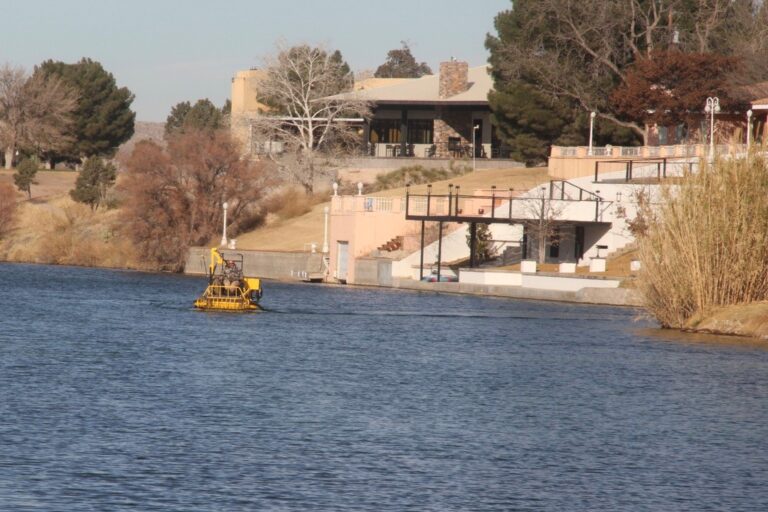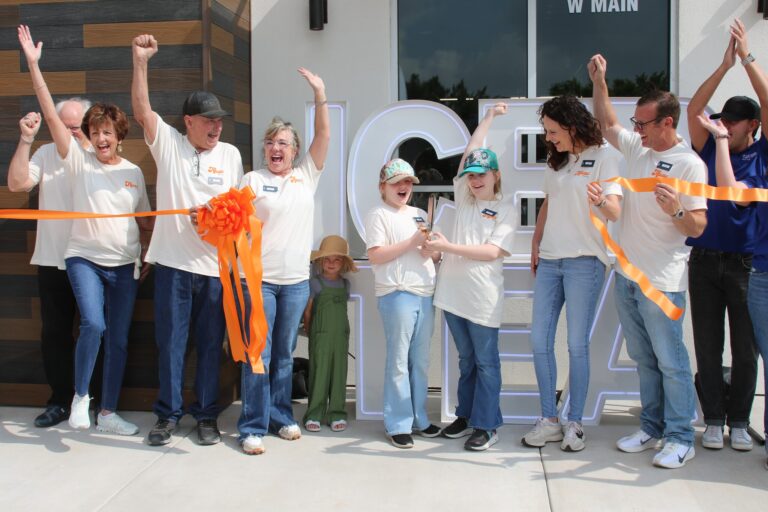Residents, chamber, and the city work to tame ‘aquatic bloom’ in Pecos River

Jake Cooper
El Rito Media
A river algae problem that threatened to sink Carlsbad’s popular Christmas on the Pecos festivities appears to be under control, at least for now.
City officials say measures taken to subdue the burgeoning vegetation, including the use of mechanical harvesters that pull algae out of the water, have reduced the growth to a manageable level.
The harvesters were deployed last fall to combat the heavy algae that reportedly started appearing in the river in July 2022.
Nancy Brantley, who lives along the river on Riverside Drive, said the bloom eventually became “a solid mat across the river.”
Deputy City Administrator KC Cass said the city bought two Weedoo TC Work Series mechanical aquatic weed harvesters for about $175,000 to remove the algae from the water. So far, he said, the city has removed and disposed of 125 dumpsters (about 30 cubic yards each) of the algae.
City officials notified the New Mexico Department of Game and Fish of the problem in 2022, and samples were collected. The New Mexico State University Plant Diagnostic Clinic identified the samples as brittle naiad and Eurasian milfoil, both plants that are considered invasive by the clinic.
A third species, sago pondweed, was identified by Game and Fish in April 2024, according to a letter sent by the city to residents with homes along the river.
The “aquatic bloom” has barbs that attach to swimmers, researchers said. Many have reported that the weeds can easily tangle with the blades of boats.
Brantley said her family stopped boating on the river “because it’s so bad, it sucks up the growth, and then (the motor) gets stopped up and then you’ll ruin your motor.”
‘Acting responsibly’
A diagnostic report from NMSU Plant Diagnostic Clinic said herbicides should not be used. The clinic suggested the city try physically removing the weeds. Cass said the city decided to proceed as the clinic suggested and set out to address the problem without contaminating the water with chemicals from herbicides.
“I think acting responsibly is the way to go,” he said. “We were fortunate to find the people that we did to come and help us. They did a tremendous job to help train us and get some of this stuff out.”
Not only did the bloom affect private boat owners, but it also was on the verge of impacting Christmas on the Pecos, the annual event that features boat tours along the river to view homes decorated for Christmas. The 45-minute boat rides start the day after Thanksgiving and continue until New Year’s Eve.
Sponsored by the Carlsbad Chamber of Commerce, Christmas on the Pecos is one of the chamber’s biggest fundraisers each year. Chamber Chief Executive Officer Chad Ingram said about 15,000 people rode the boats last year, an estimated 75% percent of them from outside Eddy County.
Two Weedoos could be spotted on the Pecos harvesting the algae through early November, clearing the way for Christmas on the Pecos. The harvesters did their job, and the boat rides continued as planned.
Ingram said that although business was not affected by the algae, he felt bad for those who came to Carlsbad over the summer and “probably didn’t have the best experience. I think it affected our local individuals a lot, not being able to get out there.”
Long-term solutions
The machines weren’t the city’s first attempt to combat the algae.
New Mexico Game and Fish permitted the introduction of triploid grass carp into the river to eat the algae, reducing its size and clearing the water. From July 2022 to June of last year, 4,750 carp were released at a cost of $35,750, according to a letter city officials sent to residents.
Cass said that once the Weedoo trims the algae to an acceptable level, the carp eat the plants to keep the bloom at bay. He said the river will be monitored for algae growth.
“We’ll continue to run our boat and cruise five days a week,” he said.



